Dr: When was your last normal menstrual period (LNMP)? 
Lady: em…sometime last month, I think!
Dr: Pls can u be more specific?
Lady: I can’t remember exactly…
Dr: What’s your regular/usual cycle length?
Lady: em…most times it flows well for 3 days, then…
Dr: Sorry to cut u short, but I meant the cycle length…that is the number of days between one period and the next
Lady: Oh I see…its every month na!
The above is an excerpt from a typical discussion between a Dr and a female patient…and its exasperatingly quite common. Its amazing to realise how many ladies know so little about their menstrual cycle pattern or understand that therein lies the clue to many gynaecological problems!
Let’s briefly undertake a study of some relevant details of the menstrual cycle.
Menstrual cycle: a series of cyclical events, the physical hallmark of which is the menstruation (period), that characterises the reproductive years of the female.
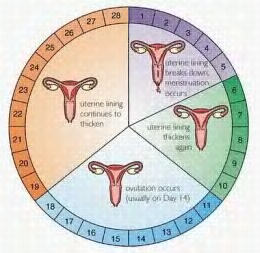 Menstruation: a cyclical vaginal bleeding due to the sloughing off of the uterine (“womb”) wall that had been prepared for implantation of the foetus. It thus indicates that fertilization did not occur and hence the absence of pregnancy. Typically lasts 3-5 days though normal 1-8 day flows have been reported.
Menstruation: a cyclical vaginal bleeding due to the sloughing off of the uterine (“womb”) wall that had been prepared for implantation of the foetus. It thus indicates that fertilization did not occur and hence the absence of pregnancy. Typically lasts 3-5 days though normal 1-8 day flows have been reported.
Menarche: The vety first menstrual flow a female experiences…typically during her teens. It marks the transition into sexual maturity and the onset of reproductive capability.
A Cycle: The number of days from the start of one “period” to the beginning of the next. It varies from one female to the other, üsually 26 – 32 days, with an average of 28days amongst the populace. Conventionally, each day is assigned its corresponding number starting with Day 1 on the first day of the “period”.
Ovulation: the expulsion/release of the ovum (egg) from the ovary.
Menstrual cycle-related changes:
Breast: The breast swelling, tenderness, and pain experienced by many women during the 10 days preceding menstruation are probably due to distention of the ducts, hyperaemia, and oedema of the interstitial tissue of the breasts. All of these changes regress, along with the symptoms, during menstruation.
Mittelschmerz: Most females experience a fleeting lower abdominal pain during the second part (“half”) of their cycle.
Menstrual cycle abnormalities:
Menorrhagia: this refers to excessive vaginal bleeding during menstruation. Usually associated with a prolonged period of flow (longer than 7 days) and passage of clots. Common causes include fibroids, use of IUCDs, chronic pelvic inflammatory disease, etc. Although, sometimes there may be no identifiable cause.
Oligomenorrhoea: irregular periods characterised by a prolonged cycle length (usually greater than 35days but less than 6 months).
Polymenorrhoea: frequent, shortly-spaced menstruation; cycle length usually less than 21days.
Amenorrhoea: refers to an absence of menstruation. Its described as “primary” when the patient has never had a menstrual flow. Its “secondary” when there’s no menstruation for longer than 6 months after regular cycles have been established. Pregnancy, breastfeeding and menopause are normal (physiological) causes of secondary amenorrhoea. In the absence of these normal causes, a proper evaluation is necessary to determine the cause.
Dysmenorhea: refers to pain during menstrual flow and is quite common among females. That which occurs after years of painless menstruation is most likely secondary to organic disease. Classically, the pain consists in varying proportions of a continuous lower abdominal component, which may radiate to the back and thighs. There are also intermittent cramps. Pain usually begins 12-24hrs. before the onset of the menstrual bleeding and regresses significantly within 72hrs. of the onset of menstruation. Nausea, vomiting, fatigue, headaches, and diarrhea may accompany the pain. Generally, significant reduction in pain would be expected after her first childbirth.
Menstrual Cycle Regulation & Fertility Predictors
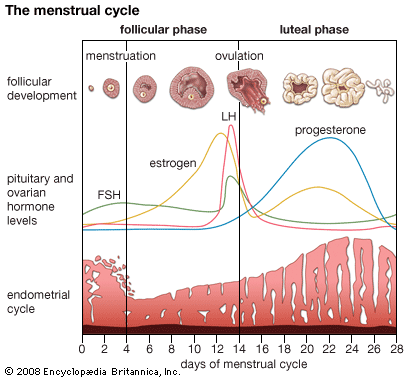
The menstrual cycle is regulated and influenced by several hormones working in a tightly controlled “loop”. These hormones include Follicle Stimulating hormone (FSH), Luteinizing hormone (LH), Oestrogen, Progesterone, etc.
Oestrogen makes the cervical mucus thinner and more alkaline, changes that promote the survival and transport of sperms. Progesterone makes it thick, tenacious, and cellular. The mucus is thinnest at the time of ovulation, and its elasticity increases so that by midcycle, a drop can be stretched into a long, thin thread.
Based on the activity of these hormones, the cycle can be divided into 2 parts (follicular and luteal phases). The second part is usually always 14 days long while the first part varies in length from one female to the other; hence the variation in cycle lengths.
Ovulation normally occurs about 9 hours after the peak of the LH surge at midcycle (in a 28day cycle; 14 days before the next expected menstrual flow in others). The ovum lives approximately 72 hours after it is extruded from the follicle (in the ovary), but is probably fertilizable for less than half this time.
NB: some sperms can survive in the female genital tract and produce fertilization for up to 120 hours before ovulation, but the most fertile period is clearly the 48 hours before ovulation.
 Calendar Method: before relying on this method, record the number of days in each menstrual cycle for at least 6 months, and take note of the longest and shortest cycles. Subtract 18 from the length of d shortest cycle to get the estimated first day of fertile time/period. Subtract 11 from the length of longest cycle to get the last day of fertile time.
Calendar Method: before relying on this method, record the number of days in each menstrual cycle for at least 6 months, and take note of the longest and shortest cycles. Subtract 18 from the length of d shortest cycle to get the estimated first day of fertile time/period. Subtract 11 from the length of longest cycle to get the last day of fertile time.
E.g.; If recorded cycles vary from 26 to 32 days,
26 – 18 = 8.
32 – 11 = 21
Thus fertile time/period (in this case) is from day 8 to day 21!
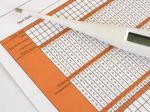 Basal Body Temperature (BBT): a woman’s temperature rises 0.2-0.5’C (degrees centigrade) around d time of ovulation and persists for about 3 days. The woman must take her body temperature in d same way, at the same time each morning before she gets out of bed using a suitable sensitive thermometer and record this on a special graph. Only after the 3 full days of BBT rise is she considered in her non-fertile/safe period until the next menstrual flow.
Basal Body Temperature (BBT): a woman’s temperature rises 0.2-0.5’C (degrees centigrade) around d time of ovulation and persists for about 3 days. The woman must take her body temperature in d same way, at the same time each morning before she gets out of bed using a suitable sensitive thermometer and record this on a special graph. Only after the 3 full days of BBT rise is she considered in her non-fertile/safe period until the next menstrual flow.
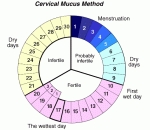 Cervical secretions: by understanding the changes in the consistency of secretions from her cervix, a female can learn to tell when she is fertile or not with a fair level of certainty.
Cervical secretions: by understanding the changes in the consistency of secretions from her cervix, a female can learn to tell when she is fertile or not with a fair level of certainty.
However, for those interested in the “rhythm method” of contraception, it should be noted that there are rare but documented cases in the literature of pregnancy resulting from isolated coitus on every day of the cycle.
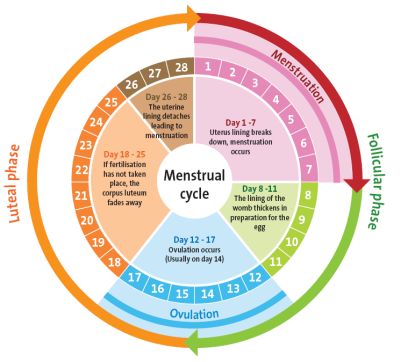
Manifestations during the menstrual cycle may include a premenstrual feeling of lethargy, tiredness, headaches, excitability, and fullness with tenderness of breasts, and increased acne spots. These features, which disappear with the onset of menstruation, are termed the menstrual molimina. They are usually mild but designated the premenstrual tension syndrome when they are significant enough to affect the patient’s daily routine.

Reblogged this on dr LJ Kriel (Olivedale).
Thanks for the info. Please can you write about pelvic floor muscle collapse or prolapse of pelvic organs in a woman and how to avoid it. Most grateful.
I also have a question. Is it possible and safe to do a tummy tuck in the process of having a baby through ceasarian operation?
Ok. Will put together something on thatbsoon.
No, its not routinely practised nor advisable to have both procedures at d same time. Besides, the uterus has to be given time to contract back to its pre-pregnancy size before expecting any appreciable result from d other surgery.
Okay. Many thanks
Plz doc I nid ur help,my menstral cycle varies.in d month of august I saw it on d 9 nd septmber it wz on d 6.bc of dis I find it dificult to knw my ovulation period
Like mentioned in the post, it’s not about the specific date in the month but rather about the number of days between one flow & the next. Pls use the email address naija.medic247@gmail.com for further enquiries if privacy is needed.
Is it normal for a period to last for three days and the flow is light?
Is that the way the previous periods have been? Any change in the cycle length?
What was your source for the menstrual cycle wheel?
Please what causes rashes around a Vagina?
Several possible causes depending on the exact nature of the rash…including STDs, razor/shaving bumps, efc
Pls can person have pain during menstruation truout?
Want to copy articles from other pages rewrite them in seconds and post on your blog, or
use for contextual backlinks? You can save a lot of writing
work, just search in google:
Daradess’s Rewriter
Pls Doc, what could av happen to a lady lactating (water in colour) without being pregnant and several drugs av been used e.g Primolut N, Brimocriptine and samething persist. Thanks
Pls, my cycle length is 18 days, its been that way for about 6 months, is it normal or should i be worried? Thank You.
Thanks very much for the education
please i had sex with my guy today,and the 2nd week after my menstruation,can i be pregnant .my mebstrual cycle length is 25